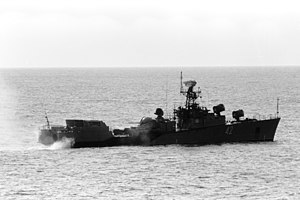
Back Projekt 204 Czech Poti-Klasse German ناوچه کلاس پوتی Persian Classe Poti Italian ポチ型コルベット Japanese Малые противолодочные корабли проекта 204 Russian Projekt 204 Swedish
 Bulgarian Navy Poti-class corvette Bditelni in 1987
| |
| Class overview | |
|---|---|
| Name | Poti class |
| Operators | |
| Preceded by | Kronshtadt-class submarine chaser |
| Succeeded by | Pauk class |
| Built | 1960–1968 |
| In service | 1960–2005 |
| Completed | 66 |
| General characteristics | |
| Type | Anti-submarine corvette |
| Displacement |
|
| Length | 59.4 m (194 ft 11 in) |
| Beam | 7.9 m (25 ft 11 in) |
| Draught | 2.0 m (6 ft 7 in) |
| Propulsion | 2 shaft CODAG, 2 gas turbines 22,371 kW (30,000 shp) and 2 M503A diesels 5,966 kW (8,000 bhp) |
| Speed | 38 knots (70 km/h; 44 mph) |
| Range |
|
| Complement | 80 |
| Sensors and processing systems |
|
| Armament |
|
The Poti class was the NATO reporting name for a group of anti-submarine warfare (ASW) corvettes built for the Soviet Navy. The Soviet designation was Project 204 small anti-submarine ships. These ships were the first Soviet warships powered by gas turbine engines; two propellers were mounted in tunnels to give a very shallow draught. A twin 57 mm (2 in) gun mounting provided self-defence. Three ships of the class were exported to Romania and six to Bulgaria during the Cold War. By 2008, all ships of the class were no longer extant.